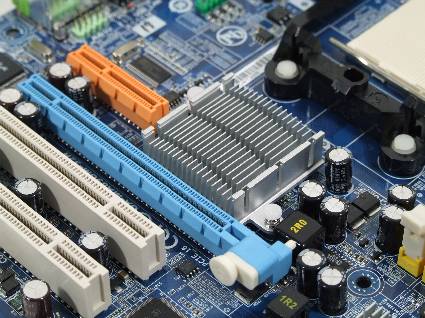Do-It-Yourself Solar-Powered PC: Hardware
Energy-saving Motherboard: Gigabyte With HDMI And DVI
The limits of solar energy mean that we can't even consider a separate graphics card in our build. They simply require much too much power to run, whether we consider a passively cooled graphics card or a high-end model. According to our measurements, even a small, passively cooled ATI Radeon X1300 draws 88.5 W at idle. This level of energy consumption exceeds that of our entire system, including the monitor!
GA-MA69GM-S2H motherboard
To take advantage of the most current technologies and to permit our solar-powered PC to function as a video playback device, we chose the Gigabyte GA-MA69GM-S2H motherboard. This motherboard is equipped with the AMD 690G chipset, and supports both HDMI and DVI with HDCP output, as well as VGA. In tandem with the CPU, this chipset delivers enough computing power to play back high-definition video (HD-DVD or Blu-ray).
This board delivers video output via HDMI, DVI, and VGA.
This Gigabyte board comes in the microATX format. A great many motherboards with integrated graphics are available in this form factor, because they're widely used by OEMs in applications where add-on cards are seldom needed. Nevertheless, this motherboard does include a PCIe x16 slot, a PCI-e x1 slot, and two PCI slots as well.
The Southbridge chipset delivers on-board graphics, but this motherboard also includes a PCIe x16 slot for a graphics card as well
The port block shows the various connections available from this motherboard
Get Tom's Hardware's best news and in-depth reviews, straight to your inbox.
Current page: Energy-saving Motherboard: Gigabyte With HDMI And DVI
Prev Page 1 Watt Active Cooling Takes Very Little Power Next Page Energy-saving Motherboard: Gigabyte With HDMI And DVI, ContinuedTom's Hardware is the leading destination for hardcore computer enthusiasts. We cover everything from processors to 3D printers, single-board computers, SSDs and high-end gaming rigs, empowering readers to make the most of the tech they love, keep up on the latest developments and buy the right gear. Our staff has more than 100 years of combined experience covering news, solving tech problems and reviewing components and systems.
-
Raigedas i bought this M2-ATX PSU (actually to of them). but i was unable to start it.Reply
1. first quick question: is it possible to start (for testing purposes) the PSU without connecting it to the computer? is it enough to short circuit J8 only to start?
2. docummentation is unclear about 10 (J6). it looks like J6 is purely for controlling stereo amplifier. but other place of the manual says "if J6 is cnnected to the motherboard". where to motherboard?
3. how should PSU be connected?
for testing i have taken 12V 7Ah lead acid battery fully charged.
connected battery "-" to J4.
battery "+" to J1.
J3: tried to leave not connected and tried to connect battery "+".
disconnected power switch cable from motherboard and connected it to J9.
connected J8 with motheboard (using little cable included in the package) where power switch was originally connected.
left J6 not connected.
J10 not connected (P0 mode). also tried P1 mode.
connected ATX and P4 (J2).
pressed power on my pc but nothing happened and no voltage on MOLEX cable.
could authors of the article (or maybe other owner of the PSU) describe how did they start the PSU?




